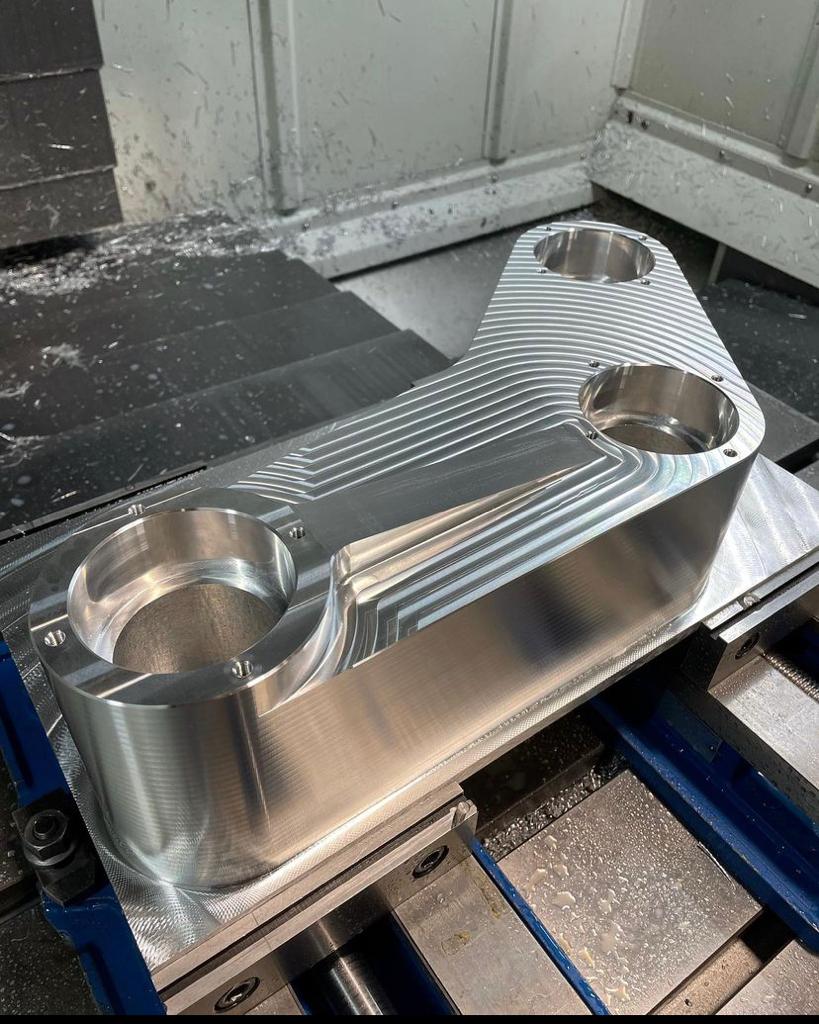CNC Machining Techniques: Revolutionary Methods
Few developments in the field of contemporary manufacturing have had the same revolutionary effect as computer numerical control (CNC) machining. The potential for industrial production has been completely reimagined by this ground-breaking technology, which provides unmatched accuracy, effectiveness, and adaptability. It is critical for engineers, industrial designers, metalworking specialists, and everyone else involved in manufacturing to comprehend the possibilities of CNC machining. Let’s examine the various advantages that MiaMakina CNC machining techniques provide and see how they have transformed industrial production.
A key technology that is changing the way we create goods is Computer Numerical Control (CNC) machining, which stands out in the ever-changing environment of industrial production. Let’s explore the meaning, principles, and significant effects of CNC machining on manufacturing.
Definition and fundamentals of CNC machining
CNC machining involves the use of computerized systems to control machine tools, guiding them through precise movements and operations to create complex parts and components. Unlike conventional machining, which relies on manual intervention, CNC machining automates the manufacturing process, offering unparalleled accuracy and repeatability.
Important Elements of CNC Machining:
• Computer Control: Advanced software systems dictate how CNC machines move and behave, translating digital blueprints into tangible products.
• Machine Tools: CNC machines include a broad variety of tools, such as mills, routers, grinders, and lathes, each designed to perform a particular manufacturing activity.
• Tooling: CNC systems precisely manage drills, cutting tools, and other implements to ensure optimal performance and consistent outcomes.
• Workpiece: The material or object being machined is precisely shaped, cut, drilled, or milled in accordance with the CNC system’s parameters.
The rise and importance of CNC machining in industrial production
The evolution of CNC machining has been nothing short of revolutionary, transforming industrial production across diverse sectors. Its rise to prominence can be attributed to several key factors:
The transition from traditional machining methods to CNC machining
The evolution from traditional machining methods to CNC machining represents a significant milestone in the history of manufacturing. Traditional machining relied heavily on manual operation, where skilled machinists operated lathes, mills, and other machine tools to shape raw materials into finished products. However, this approach had limitations in terms of precision, efficiency, and repeatability.
The advent of CNC machining revolutionized the manufacturing landscape by introducing automation and computer control to machining processes. Instead of manual intervention, CNC machines are programmed with precise instructions using numerical data, guiding the movement of cutting tools and workpieces with unparalleled accuracy and consistency.
Recent Developments and Innovations in CNC Technology:
In recent years, CNC technology has undergone significant advancements and innovations, further expanding its capabilities and applications across industries. Some of the notable developments include:
• High-Speed Machining (HSM): Advances in spindle technology, cutting tools, and machine dynamics have enabled High-Speed Machining (HSM) techniques, allowing CNC machines to operate at significantly higher speeds while maintaining precision and surface finish.
• Multi-Axis Machining: The evolution of multi-axis CNC machines, including 4-axis, 5-axis, and even higher-axis configurations, has enabled the production of complex parts with intricate geometries. Multi-axis machining enhances efficiency, reduces setup times, and expands design possibilities for aerospace, automotive, and medical applications.
• Advanced Tooling and Materials: Innovations in cutting tool technology and materials have improved machining performance and expanded the range of materials that can be processed with CNC machining. Carbide, ceramic, and diamond-coated tools offer enhanced wear resistance and cutting performance, while advancements in composite materials enable the machining of lightweight and high-strength components.
High Precision and Repeatability
In the realm of modern industrial production, CNC machining stands as a cornerstone of efficiency and precision. With CNC machining, manufacturers can achieve unparalleled levels of accuracy and repeatability, making it indispensable for the production of complex parts across a wide range of industries.
The level of precision in CNC machining
In the manufacturing industry, CNC machining offers the highest degree of precision. CNC (Computer Numerical Control) devices may achieve incredible accuracy and extremely tight tolerances and accurate measurements. Several aspects of CNC machining are intrinsic to its precision, including:
• Automated Control: By using computerized instructions to guide their equipment, CNCs remove the possibility of human error that might arise during manual tasks. This automatic control makes sure that every machining operation is carried out accurately and consistently.
• High-quality machine tools: CNC machines are outfitted with high-precision parts like linear guides, ball screws, and high-resolution encoders, which enable workpieces and cutting tools to move smoothly and precisely.
• Material Considerations: The machining process and the level of precision attained are influenced by the qualities of the workpiece material, such as hardness, machinability, and thermal conductivity. A vast variety of materials, including metals, polymers, composites, and ceramics, can be precisely machined using CNC technology to meet unique needs.

Achieving repeatability and consistency in production
Achieving repeatability and consistency in production is paramount for ensuring the quality and reliability of manufactured goods, especially in the realm of CNC machining techniques and inhttps://miamakina.com/en/cnc-processing/dustrial applications. In CNC machining, where precision is critical, several strategies are employed to maintain this consistency:
• Programmed Instructions: CNC machines follow preprogrammed instructions to ensure accurate and consistent execution of every machining operation. For consistency across several production runs, these instructions offer comprehensive parameters for tool paths, cutting speeds, and feed rates.
•Workpiece Fixturing: Keeping repeatability in CNC machining requires proper workpiece fixturing. Throughout the machining process, the workpiece is firmly held in place by precision fixtures and clamping devices, which guarantee uniform positioning and alignment.
•Quality Control Measures: During machining, part dimensions and characteristics are checked using in-process inspection techniques such measurement systems and probing. Parts can be made sure to satisfy quality requirements by continuously checking dimensions against predetermined tolerances. Deviations can then be found and fixed in real time.
•Process Monitoring and Feedback: In order to evaluate the performance of the machining process, advanced CNC systems include monitoring and feedback devices. Variations from anticipated values can be found early on by keeping an eye on variables like spindle speed, cutting forces, and tool wear. This allows modifications to be made to preserve process stability and uniformity.
Efficiency in Production Processes
To stay ahead of the curve in today’s competitive industrial world, production efficiency and speed are critical. Technological developments and process optimization have made major progress possible in the field of CNC machining.
Increasing speed in machining processes
For manufacturing operations to increase productivity and save lead times, machining processes must be accelerated. Technology breakthroughs and process optimization have allowed manufacturers to increase machining rates without sacrificing accuracy or quality. CNC machines can function at higher speeds without sacrificing precision because to methods like adaptive machining, improved tool paths, and high-speed machining (HSM). In today’s fast-paced industrial environment, producers can enhance throughput, save production costs, and maintain their competitiveness by speeding up machining.
Reducing material waste and operational efficiency
Reducing material waste and enhancing operational efficiency are paramount priorities at Mia Makina. With our dedication to optimizing processes and minimizing waste, we strive to maximize resource utilization and overall efficiency in every aspect of our operations.
Industrial Applications
Numerous sectors use CNC machining extensively, as it transforms manufacturing procedures and makes it possible to produce intricate and exact components. The following are some important industries where CNC machining is essential:
Use of CNC in the automotive sector
CNC machining plays a crucial role in the automotive industry’s production of essential parts, including chassis, body panels, engine and gearbox components. High-precision machining of metal and plastic components is made possible by CNC machines, which guarantee precise surface finishes and tight tolerances. Automobile manufacturers can produce parts that satisfy the exacting standards of the industry consistently, reliably, and efficiently by utilizing CNC technology.
The role of CNC machining in the aviation and aerospace industry
In the aviation and aerospace sectors, where dependability, accuracy, and safety are crucial, CNC machining is essential. CNC machining is used to create intricate structures including engine parts, landing gear, fuselage panels, and structural pieces for both spacecraft and airplanes. By meeting strict safety and performance requirements, CNC machines help aircraft manufacturers reach the high levels of precision and quality needed for vital aerospace applications.
The importance of CNC techniques in medical device production
With remarkable accuracy and precision, CNC technology is utilized to create orthopedic devices, prostheses, implants, surgical tools, and diagnostic equipment. Medical practitioners and patients may rely on dependable, high-quality goods thanks to CNC machining, which guarantees that medical devices fulfill stringent regulatory criteria and quality standards.
Complex Part Production
Complex part production is where CNC machining truly shines, demonstrating its prowess in fabricating intricate geometries and intricate components with unparalleled precision and versatility. Here’s how CNC technology facilitates the production of complex parts:
Production of complex geometries and parts with CNC
CNC machines can accurately regulate tool movement and cutting parameters, they are excellent at turning complex designs into tangible products. CNC technology is a vital tool for producing complicated parts in a variety of industries because it allows producers to achieve high levels of accuracy and reproducibility, regardless of the complexity of the features, curves, or contours of the product.
Material Diversity and Flexibility
Among the many alternatives available to businesses for material selection, CNC machining stands out for its exceptional flexibility and diversity of materials. Here are some areas where CNC technology shines:

The ability to work with various materials
CNC machining techniques empower manufacturers to work with an extensive range of materials, spanning metals, plastics, composites, and even exotic materials. This versatility enables the fabrication of diverse components across different industries, from automotive parts to medical devices.
Production flexibility and a wide range of material choices
CNC machines provide unparalleled production flexibility, allowing for swift setup and changeover between different materials and part geometries. Whether it’s aluminum, steel, titanium, or unconventional materials like ceramics or wood, CNC technology empowers manufacturers to select the most suitable material for their specific application needs. This flexibility ensures that CNC machining remains an adaptable solution capable of addressing a variety of manufacturing requirements.
The Future of CNC Machining Techniques
As we look ahead, CNC machining is poised to play a central role in shaping the future of manufacturing. Here’s what lies ahead for CNC technology:
The place of CNC in Industry 4.0 and smart manufacturing systems
A great example of the future of CNC machining is the emergence of Industry 4.0 technologies, such as the Internet of Things (IoT) and big data analytics. These technologies allow CNC machines to communicate with each other and with other systems in real time, enabling them to share data and coordinate their actions. This can help to improve the efficiency and speed of the manufacturing process, and it can also reduce the risk of errors and defects.
Expected developments in CNC machining technology
The future of CNC machining holds exciting possibilities. Anticipated developments include advancements in precision and speed, facilitated by improved control algorithms and high-performance machining strategies. Additive manufacturing techniques integrated with CNC machining will enable the fabrication of complex geometries with greater efficiency and reduced material waste. Furthermore, developments in materials science will expand the range of materials compatible with CNC machining, opening up new opportunities for innovation across industries.
Conclusion: How to Create a Revolution in Industrial Production with CNC Machining Techniques?
Conclusion: How to Create a Revolution in Industrial Production with CNC Machining Techniques?
In conclusion, CNC machining techniques have ushered in a new era of efficiency, precision, and innovation in industrial production. By harnessing the advantages of CNC machining and staying abreast of recent developments in technology, manufacturers can unlock a world of possibilities for creating complex parts with unprecedented quality and speed.
The advantages of CNC machining in industrial production are manifold. From increased productivity and reduced lead times to improved quality control and design flexibility, CNC technology empowers manufacturers to stay competitive in today’s fast-paced market. By leveraging CNC machining techniques, companies can streamline their production processes and achieve greater efficiency and profitability.
Embracing Recent Developments in CNC Machining Technology
Staying abreast of recent developments in CNC machining technology is crucial for driving innovation and staying ahead of the curve. Advances in control systems, tooling, and materials science continue to push the boundaries of what’s achievable with CNC machining, enabling manufacturers to tackle increasingly complex projects with confidence and precision.
The production of complex parts with CNC machining represents the pinnacle of precision engineering. By harnessing the capabilities of multi-axis machining, advanced tooling strategies, and additive manufacturing integration, manufacturers can realize their most ambitious design concepts with ease. From intricate aerospace components to high-precision medical implants, CNC machining offers endless possibilities for creating complex parts that meet the stringent demands of modern industries.




